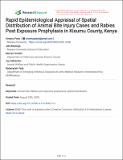| dc.contributor.author | Omemo Peter, Job Wasonga, Morvan Omollo, Joy Adhiambo, Redemptah Yeda | |
| dc.date.accessioned | 2022-01-28T07:14:15Z | |
| dc.date.available | 2022-01-28T07:14:15Z | |
| dc.date.issued | 2020 | |
| dc.identifier.uri | https://repository.maseno.ac.ke/handle/123456789/4712 | |
| dc.description.abstract | Animal bites in humans provide an important source of epidemiological information which is crucial in
enhancing rabies surveillance in humans and animals. Rabies post exposure prophylaxis consumes
substantial resources and exerts a lot of financial burden on animal bite injury victims and consumes
resources and time. The overall objective of this study was to conduct a rapid epidemiological appraisal
of animal bite injury and rabies post exposure prophylaxis in Kisumu County, Kenya.
Methods
A retrospective cross-sectional study was conducted in 32 administrative units (Sub-locations or wards)
in Kisumu County, Kenya. Data was collected from outpatient department (OPD) registers in four peri urban health centres in Kisumu East Sub County, Kenya. An integration of epidemiological tools for
disease mapping was applied in the study. Quantum Geographic Information System was used to create
a thematic map and spatial distribution of the animal bite injuries in Kisumu County.
Results
There were 133 (63%) males and 78(37%) female cases. The range in age was 11 – 40 years. The cases
were highest among 11-17 years age group. Among the cases were 14( 6.6% ) children less than 10 years
, 63(29.9% ) were of age group between 11-17 years, 49(23.2%) were in the age group between 18-24
years, 41(19.4%) were in the age bracket between 25-31 years, 24 (11.4%) were between 32 and 38 years,
while 20(9.5%) were 38 years and above. Majority, (87.2 %) of the animal bite injuries were inflicted by
domestic dogs. Wild dogs/stray dogs contributed 8.1% of the total number of animal bite injury cases.
Cats and unknown animals contributed 1.4% and 3.3 respectively. The epidemiological curve shows that
more than one case of animal bite injury occurred daily in Kisumu County between June and December,
2019 with the highest daily figure being 7. The study revealed the need to strengthen animal bite injury
and rabies prevention and control strategies in Kisumu County | en_US |
| dc.publisher | Research Square | en_US |
| dc.subject | Animal bite, Rabies post exposure prophylaxis, spatial distribution | en_US |
| dc.title | Rapid Epidemiological Appraisal of Spatial Distribution of Animal Bite Injury Cases and Rabies Post Exposure Prophylaxis in Kisumu County, Kenya | en_US |
| dc.type | Article | en_US |

